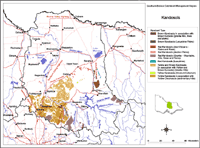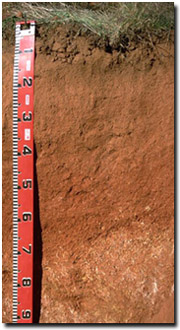Kandosols
Kandosols are non texture contrast soils (with little or gradual increase in clay content with depth) that have massive (i.e. weakly to non structured) subsoils (B horizons). They are found mainly in the upland areas, often in association with Dermosols, Chromosols and Kurosols. These soils can vary from stony hardsetting soils to deeper friable soils. Some may almost be texture contrast and have a bleached subsurface (A2) horizon. Using the Australian Soil Classification, Kandosols can be grouped further (into Suborders) based on the colour of the upper 20 cm of the subsoil (i.e. Red, Brown, Yellow, Grey and Black). These can be further differentiated based on subsoil characteristics such as nutrient level capacities and ratios and the presence of carbonate or lime.
These soils are located in the Uplands, particularly close to the Dividing Range as well as the western Strathbogie Ranges and the Yea to Broadford area (where they are associated with Yellow Chromosols).
| Kandosols in the Goulburn Broken Region This broad scale map presents an overview and should only be used as a general indication of the distribution of Kandosols in the Goulburn Broken Region. It shows areas where Kandosols are most likely to occur within the region. Note that other soil types may also occur within these mapped areas (although they are likely to be a more minor component). |  Kandosols in the Goulburn Broken Region |
This map has been developed from work done by DPI's former Centre for Land Protection Research (CLPR) as part of the Goulburn Broken Dryland Regional Development Project. This work utilised existing surveys, remote sensing information and some additional field work to develop an updated 1:100 000 soil/landform coverage across the region. Soils are difficult to map at this broad scale because of their diversity. Even in relatively small areas, a number of soils may occur which relate to differences in topography and landscape position. Variation in some of the major soil profile properties can also occur within these mapped areas. Any agricultural enterprise should be based on a proper on-site assessment of the soil and landscape. A number of soil surveys have been completed in this region at varying scales and intensity. However, in some areas very little soil survey has taken place (refer to the Soil and Land Survey Directory). | |
| Red Kandosols Similarly to the Red Dermosols, Red Kandosols are found in the higher rainfall areas of the region. The main locations are the Mt. Disappointment and Black Range (Narbethong) plateaus as well as west of Mt. Buller. These occurrences are associated with granitic parent material. Surface soils are generally organic loams (often fine sandy) and granular in structure. Subsoil (B) horizons are generally acidic and weakly to non-structured (earthy in appearance) reddish clay loams to medium clays. The field texture test can often underestimate clay content in these soils (i.e. they have a higher clay content than the hand texture would suggest) due to their clay composition. Red Dermosols and Ferrosols are similar in this way. There are sometimes brown variants of this soil type in association with the red subsoil types. These soils are characteristically friable, unlike Kandosols in lower rainfall areas. Brown and Yellow Kandosols Brown and Yellow Kandosols are found primarily on the uplands of the western Strathbogie Ranges (where they occur in association with Brown and Yellow Kurosols), the Yea – Broadford area and to the north of Mansfield. The Red Kandosols are located generally in drier areas. Soil type characteristics range from having minimal profile development (but still >15% clay in the subsoil) to soils which may have hardsetting, bleached subsurface horizons with ironstone gravel (nodules/concretions) and noticeable colour change down the profile. Similarly to Dermosols there are often sequences of soil development associated with topographic position in the landscape and to some extent aspect (e.g. harder setting soils on drier aspects). Generally these soils are acidic to neutral. This may vary depending on their parent material (i.e. granite). Often these soils are associated with weakly developed soils (i.e. Tenosols) in granitic areas. |  Red Kandosol developed on granite |

